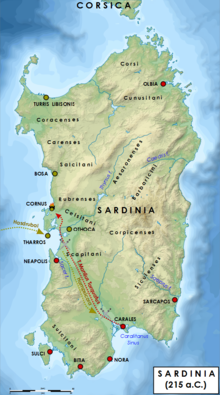Hampsicora
Hampsicora (3th century BC - Cornus, 215 BC) was a Carthaginian military and landowner of Sardinia, the leader of the anti-Roman revolt of 215 BC.

The sources describe Hampsicora as the richest among the landowners of Sardinia that at time appeared to be split into two entities: the southern and western coastline, including the vast Campidano plain, directly subjected to the domination of Carthage and the mountainous inland areas still independents and inhabited by the Nuragic populations, which, although become tolerant of the Carthaginians after many hostilities, were obviously hostile to the Roman conquest.
In conjunction with the victories of Hannibal in Italy, Hampsicora was the animator, along with Hanno of Tharros, of the revolt of the coastal cities of Sardinia against the Romans in the 215 BC, succeeding in gaining the support of the Sardinians, especially the tribes of Ilienses. Also the senators of Cornus, the city of which Hampsicora was the chief magistrate, sent ambassadors to Carthage asking aid for the Sardinians who were aware of what was happening in Italy. Carthage then sent Hasdrubal, said the Bald, with an army of about ten thousand soldiers.
The pitched battle took place near Decimomannu, according to Francesco Casula, between the two rivers in the area, a few miles from Caralis and saw the defeat of the revolters. The Hampsicora's plan was to march on the city in order to cut off the supply routes of the other cities of the western coast fell into Roman hands. However, the Carthaginian ships, almost arrived in Cornus, were driven by the winds west to the Balearic Islands.
Meanwhile, Titus Manlius Torquatus, the Roman consul, gathered in Caralis four legions and went to Cornus. Manlio surprises the few troops of Cornus, led by Josto, son of Hampsicora, who was defeated, having made the mistake of facing the enemy in the open field without waiting for further reinforcements. In fact Hampsicora was asking reinforcements to the Sardinians and when he came there, rejoining with the Carthaginian troops who landed late, also faced the enemy, but was also defeated because the Carthaginians surrendered. He subsequently brought to safety, taking refuge among the inland tribes. However, according to Livy, Hampsicora, saddened by the death of his son Josto and eager to not fall into the hands of the Romans, took his own life.
Bibliography
- Piero Meloni, La Sardegna romana, Chiarella, Sassari, 1975; nuova ediz. ampliata 1990
- (a cura di) Attilio Mastino, Storia della Sardegna antica, Il maestrale, Nuoro, 2005; integralmente disponibile su Sardegna Cultura, portale culturale della Regione Autonoma della Sardegna, all'indirizzo http://www.sardegnacultura.it/documenti/7_93_20060719131740.pdf
- Maurizio Corona, La rivolta di Ampsicora: cronaca della prima grande insurrezione sarda (215 a. C.), Akademeia, Cagliari, 2005
- Massimo Pittau, L'eroe Hampsicora era sardo, non cartaginese, disponibile sul sito personale dello stesso autore, già Professore ordinario di Linguistica sarda presso l'Università degli Studi di Sassari, all'indirizzo http://www.pittau.it/Sardo/ampsicora.html
- Frantziscu Casula- Anmos Cardia, Amsicora, Alfa Editrice, Quartu, 2007.
- Francesco Casula, Uomini e donne di Sardegna, pagg.9-30, Alfa editrice, Quartu 2010
- Tonino Oppes, Ampsicora Eroe sardo, Condaghes, Cagliari 2014
